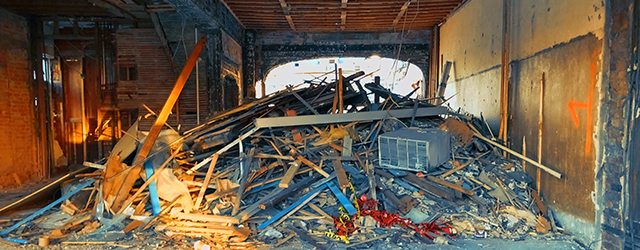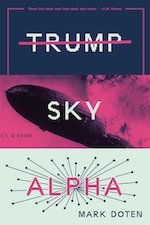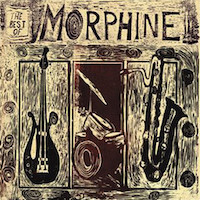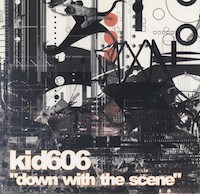
Ahoy! This is the Weekly Churn, where every Sunday I post about what I’ve been reading, watching, and thinking about over the previous week. This post is a week late, for a variety of reasons. I’d say it won’t happen again, but I’d likely be lying.
 Mark Doten’s work was recommended to me by Canadian author Andrew Sullivan. He’d actually recommended The Infernal, but I couldn’t find any copies of that. Trump Sky Alpha had just come out, so I decided to start there instead. Holy shit, what a ride. In brief: the world has ended, more or less, in the fire of nuclear war at the hands of Donald Trump and God only knows who else. A year after the event, with the world in ruins and the survivors picking up the pieces, Rachel, a former journalist who now spends her days matching faces of bodies to photographs of people known to be missing and presumed dead, is tasked by New York Times Magazine (now operating out of California in concert with the government, such as it is) to do a story on Internet joke/meme culture in the final days before nuclear war destroyed civilization as we know it. She agrees to do the story, on the condition that whatever part of the government remains functional will take her to visit the mass grave where her wife and daughter are buried. Trump Sky Alpha is satire, but it’s not humour.
Mark Doten’s work was recommended to me by Canadian author Andrew Sullivan. He’d actually recommended The Infernal, but I couldn’t find any copies of that. Trump Sky Alpha had just come out, so I decided to start there instead. Holy shit, what a ride. In brief: the world has ended, more or less, in the fire of nuclear war at the hands of Donald Trump and God only knows who else. A year after the event, with the world in ruins and the survivors picking up the pieces, Rachel, a former journalist who now spends her days matching faces of bodies to photographs of people known to be missing and presumed dead, is tasked by New York Times Magazine (now operating out of California in concert with the government, such as it is) to do a story on Internet joke/meme culture in the final days before nuclear war destroyed civilization as we know it. She agrees to do the story, on the condition that whatever part of the government remains functional will take her to visit the mass grave where her wife and daughter are buried. Trump Sky Alpha is satire, but it’s not humour.
The novel is fragmentary and seems searching for structure, which perfectly mirrors the world of the book and characters in it. It’s also got the most accurate representation of Internet culture I’ve ever seen in a book.[ref]My only complaint is that he spells “birb” as “burb.”[/ref] Trump Sky Alpha is inter- and meta-textual to the extreme, bringing together references to politic, media, meme/messageboard culture, novels, films, videogames, and everything in between to create two fallen worlds, the fallen world of before and the fallen world of after. Doten juxtaposes a cultural moment that values distance and ironic detachment with one that cannot escape intimacy and immediacy, and almost every page is some kind of gut punch, a moment of emotional intensity, be it rage or sadness or disgust. The book is neither gentle nor kind, but it does understand those things, and in a sense laments their absence. It feels like a necessary book. Also—and I’m certainly not the person to give you a deep or nuanced reading about this aspect of the book—as far as I could tell every character with a speaking role except for Donald and Ivanka Trump is queer. I don’t know that I’ve ever read a post-apocalyptic story about queer characters before, but it was fascinating in the same way that Ann Leckie’s work with pronouns is fascinating, in the sense that it changes nothing while also changing everything. Anyway, Trump Sky Alpha is easily one of the best books I’ve read so far this year.
Deadwood has returned to television with a movie, one last effort to realize David Milch’s vision, to wrap up loose plot threads and revisit much-loved characters. It was very satisfying, but I wish it had been longer. It didn’t do much but give us a glimpse a few years down the road, very much in media res, and send some players to their final rest. It was a revisiting, a last look, changed but not changed, and I think any effort to do more would have been a failure. As it was, it felt like, finally, an ending. Deadwood has always been the opening move in HBO’s story of America, charting the bloody ways that institutions emerge to solve problems that local power can’t, while The Wire lives at the other end, charting the bloody ways those institutions eventually fail and crumble. Together the two shows are maybe the best examples of what Zeynep Tufekci calls sociological storytelling.
 I’ve spent the last two weeks organizing and digitizing my substantial music collection. In 2000, maybe the last year I was buying music on CD in any kind of volume, I figured I had somewhere around 500 compact discs. Fewer than half of those ever made the transition to my digital collection, and in order to reclaim some space in our apartment I’ve finally started to buckle down and deal with them. It’s been one hell of a trip through my teens and early twenties. Music dominated my life then in a way that books would later on. I was never seen without a CD player and headphones, I played briefly in a couple of bands, made three terrible electronic albums with a piece of beginner’s software called Acid that thankfully never saw the light of day, and every time I went to Winnipeg I dug through the crates at every record store I could find looking for Japanese imports and other rare releases from my favourite bands. Every Saturday afternoon was spent at Milltown Music digging through their selection. Milltown started as a wine-making shop that had a couple racks of discs in a back corner (which is where I discovered the Jon Spencer Blues Explosion, my favourite band from that era) and eventually became a full-fledged music shop, selling thousands of discs and dozens or maybe even hundreds of instruments.
I’ve spent the last two weeks organizing and digitizing my substantial music collection. In 2000, maybe the last year I was buying music on CD in any kind of volume, I figured I had somewhere around 500 compact discs. Fewer than half of those ever made the transition to my digital collection, and in order to reclaim some space in our apartment I’ve finally started to buckle down and deal with them. It’s been one hell of a trip through my teens and early twenties. Music dominated my life then in a way that books would later on. I was never seen without a CD player and headphones, I played briefly in a couple of bands, made three terrible electronic albums with a piece of beginner’s software called Acid that thankfully never saw the light of day, and every time I went to Winnipeg I dug through the crates at every record store I could find looking for Japanese imports and other rare releases from my favourite bands. Every Saturday afternoon was spent at Milltown Music digging through their selection. Milltown started as a wine-making shop that had a couple racks of discs in a back corner (which is where I discovered the Jon Spencer Blues Explosion, my favourite band from that era) and eventually became a full-fledged music shop, selling thousands of discs and dozens or maybe even hundreds of instruments.
 I went through a lot of musical phases, as I imagine many young people do, and holding some of these objects has brought me back to some of them. I went through a period in junior high where I listened to Benny Goodman and Louis Armstrong. In high school I had the requisite Pearl Jam and Stone Temple Pilots albums, and I bought just about anything I came across from Matador Records or TVT. I listened to classic rock and had a phase where I wouldn’t listen to anything electronic, and then I discovered big beat and trip hop and digital hardcore, and I needed desperately to hear the latest digital sounds. I listened to a lot of Big Sugar. I wanted to find something different and new. The muscle memory is all still there; I can handle the discs, open the cases and remove the sleeves all without looking and without leaving dirt or fingerprints. It’s like I’m still breaking them out for daily listening, though in truth most of them have been in storage since 2012 and some of them since 2006.
I went through a lot of musical phases, as I imagine many young people do, and holding some of these objects has brought me back to some of them. I went through a period in junior high where I listened to Benny Goodman and Louis Armstrong. In high school I had the requisite Pearl Jam and Stone Temple Pilots albums, and I bought just about anything I came across from Matador Records or TVT. I listened to classic rock and had a phase where I wouldn’t listen to anything electronic, and then I discovered big beat and trip hop and digital hardcore, and I needed desperately to hear the latest digital sounds. I listened to a lot of Big Sugar. I wanted to find something different and new. The muscle memory is all still there; I can handle the discs, open the cases and remove the sleeves all without looking and without leaving dirt or fingerprints. It’s like I’m still breaking them out for daily listening, though in truth most of them have been in storage since 2012 and some of them since 2006.
 Living in a small town with one small AM radio station and no way to listen-before-buying I took a lot of chances on albums because they had interesting covers. If they did something interesting with the packaging, that was good too. I subscribed to CMJ New Music Monthly and even had a letter published in one issue, though it contained an embarrassing factual error. I bought a ton of compilation albums, movie soundtracks, and samplers. Any time there was a promo CD giveaway I was there. How else was I going to find new music when all I had was sporadic access to Much Music and a radio station that mostly played the bottom 20 of the top 40 from the ’70s and ’80s? To say that I was obsessive might be an understatement. I still have some cleaning up to do, but as of this moment my iTunes library contains 46,635 songs by 1,976 artists across 3,863 albums. It takes up 323.33 GB of disk space and would take 131 days, 13 hours, 31 minutes and 49 seconds to listen to from beginning to end.
Living in a small town with one small AM radio station and no way to listen-before-buying I took a lot of chances on albums because they had interesting covers. If they did something interesting with the packaging, that was good too. I subscribed to CMJ New Music Monthly and even had a letter published in one issue, though it contained an embarrassing factual error. I bought a ton of compilation albums, movie soundtracks, and samplers. Any time there was a promo CD giveaway I was there. How else was I going to find new music when all I had was sporadic access to Much Music and a radio station that mostly played the bottom 20 of the top 40 from the ’70s and ’80s? To say that I was obsessive might be an understatement. I still have some cleaning up to do, but as of this moment my iTunes library contains 46,635 songs by 1,976 artists across 3,863 albums. It takes up 323.33 GB of disk space and would take 131 days, 13 hours, 31 minutes and 49 seconds to listen to from beginning to end.
It’s a process. I’ll likely post more next week.
Finally, this past Saturday marked the one-year anniversary of my beautiful cat Molly’s death. I didn’t do anything to mark the day, but I felt very low in the days leading up to it, and it has been difficult to look at pictures of her. It helps that her ashes are here, and that they sit beneath a green and growing thing.